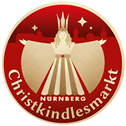A Christmas Market with a Long Tradition
The following inscription in black ink was found at the bottom of an oval, 19-centimeter-long spruce bentwood box decorated with flowers – now in the possession of the Germanisches Nationalmuseum: "Sent to Regina Susanna Harßdörfferin by Miss Susanna Eleonora Erbsin (or Elbsin) on the occasion of the Christmas Market of 1628".
The early market probably was in no way similar to the Christkindlesmarkt we know today. It was most likely a trading point for merchants selling all types of household products and items of everyday use. The original market developed throughout the 16th century more and more to a place to buy and sell Christmas gifts. As a result of the Reformation, the tradition had arisen to give children gifts on Christmas Eve rather than on New Year´s Day. A logical result is that demand for Christmas presents rose in the weeks before Christmas Eve and a "Christmas Market" evolved. Historical sources show that in the middle of the 17th century, dolls, candles, toy horses, gingerbread, marzipan and sugar were sold.
140 Stall Holders in the 18th century
A list from 1737 demonstrates that almost all Nuremberg craftsmen were represented on the market. 140 persons were entitled to offer goods for sale.
The market in the 20th century
After several relocations between 1898 and 1930, the Christkindlesmarkt returned to Nuremberg´s main market square in 1933.
Towards the end of the 19th century, the Christmas Market became less important. The National Socialists made good use of the well-established traditional event which enhanced Nuremberg's image as the "Treasure Chest of the German Reich" and was a welcome supplement to their own calendar of festive events. In 1933, the Christmas Market moved back to the Main Market Square and was a much romanticised event. An actress dressed up as a christmas angel, accompanied by two golden christmas tree fairies, recited a prologue, a children's choir sang, and church bells rang. During World War II, no Christmas Market was held in Nuremberg.
After World War II
In 1948, the Christmas Market was re-established in the Old Town which had been completely destroyed. Friedrich Bröger, head dramaturg at the Nuremberg Theatre, wrote a new prologue which – with a few changes – has been recited by the Nuremberg Christkind ever since. From 1948 up until the early 1960s, Nuremberg actress Sofie Keeser played the Christkind. Her successor, Irene Brunner, was also an actress and played the part until 1968. Since 1969, the tradition has been different: every two years a young Nuremberg woman between 16 and 19 years of age was elected as Christkind for a two-year period.






